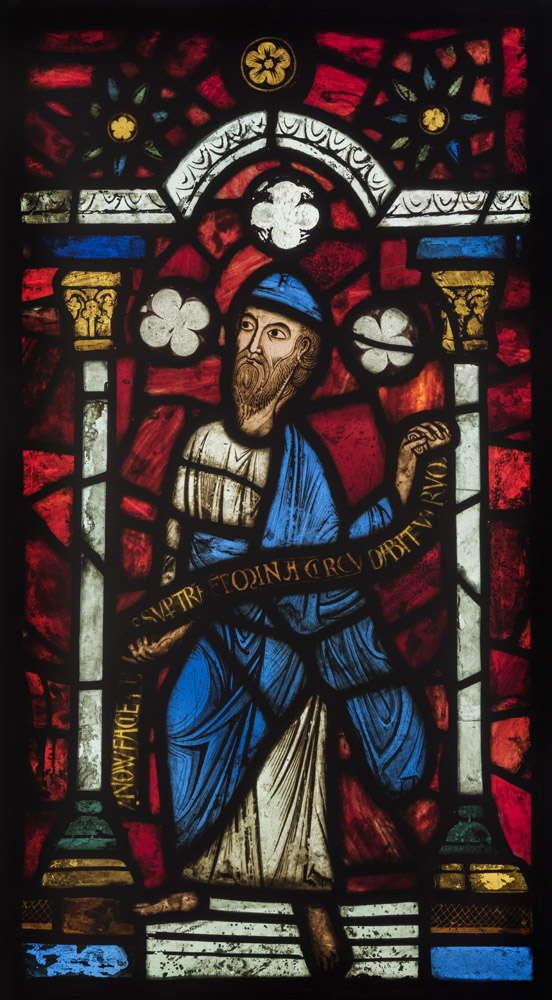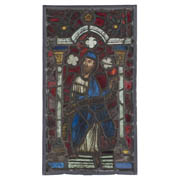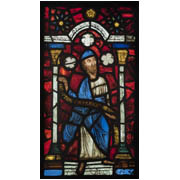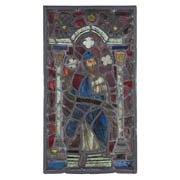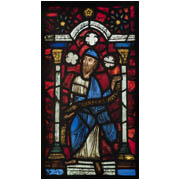Details
- Object type
stained glass panel
- Title
Prophet Jeremiah
- Place Associated
France (place of manufacture); Abbey Church of Saint-Denis, Infancy of Christ Window (place of use)
- Date
circa 1145
- Materials
white, coloured, painted glass, lead
- Dimensions
overall: 632 mm x 350 mm x 10 mm 4000 g
- Description
-
This precious window panel is the oldest piece of stained glass in Glasgow’s collections. It dates from around 1145, and was made for the Abbey of St Denis in Paris. Built in the twelfth century under the direction of Abbot Suger, the church would shape architecture and art for centuries to come. The huge expanse of windows and their jewel-like stained-glass was especially innovative. Much of this glass, including this panel, remarkably survived the destruction of the French Revolution.
This panel depicts the Old Testament Prophet Jeremiah, who holds a scroll in abbreviated Latin which translates as, ‘for the Lord hath created a new thing in the earth. A woman shall compass a man’ (Jeremiah Ch.31, v.22). This biblical quotation is often regarded as a reference to the future role of the Virgin Mary as mother of Jesus - we know that the panel originally formed part of a window series depicting the Infancy of Christ.
Sections of the window were drawn in situ at St Denis by the architect Charles Percier in 1794-95, before being removed by Alexandre Lenoir for his Musee des Monuments Francais in 1799. It was returned to St Denis on the order of King Louis XVIII around 1816-18, where it languished in store. The window was mentioned by Baron Francois de Guilhermy in his study of St Denis in the mid 19th century, which records objects still in store at the end of 1842. When Guilhermy re-inventorised the depot in 1856, the panel was not located.
The panel was drawn c.1850, by the young architect Just Lisch, and it was perhaps around this time that it entered the workshop of the glazier Alfred Gerente. Gerente was tasked by the renowned architect Viollet-le-Duc to restore the windows of St Denis, but the Jeremiah panel was omitted from the reinstated windows.
Jeremiah appears to have remained in Gerente’s workshop after his death, passing to his son-in-law in 1868. It is thought that the panel was sold to the dealer Arnold Seligman in Paris around 1900, then being acquired by Sir William Burrell in 1923. Further pieces from the Monsaingeon-Gerente workshop were sold in 1958 and are now in the hands of the French state collections.
Today this panel is feted for the excellent state of its conservation and preservation. Its authentic state was key to Michael Cothren’s argument that two collaborating artists worked on the Infancy of Christ Window. Noting, for example, that Jeremiah’s eyes are defined with two even contours, the lower being straighter than that delineating the top of the eye, and that the face is articulated with half-tones, Cothren has compared the face of Jeremiah with that of Simeon, in a panel showing the Presentation in the Temple, also from this window, now in the Church of St James, Twycross, Leicestershire. Cothren suggests that Jeremiah was painted by 'Artist A' – an artist who applied paint fussily and meticulously in short and precise strokes. This leant his output an angular style. Cothren holds that 'Artist A' was responsible for the lower registers of the window, and that he took responsibility for roughly half of the panels.
The origin of this panel was first identified by Hans Wenzel – Sir William Burrell himself was completely unaware of its importance. Following on from Wenzel's observations, the provenance of the item has been remarkably well documented, by amongst others, the great glass historian Louis Grodecki in the 1960s and 1970s, and Michael Cothren in the 1980s.
Although small in scale, the brilliant colours and finely-painted detail mark this panel out as an extremely rare and superlative example of the gothic glassmakers’ art. There are very few items of this age and quality to be found in museum collections.
Published: William Wells, Stained and Painted Glass, Burrell Collection, 1965, no. 2.
- Credit Line/Donor
Gifted by Sir William and Lady Burrell to the City of Glasgow, 1944
- Collection
Burrell Collection: Stained Glass
- ID Number
45.364
- Location
Burrell Collection
- Related People
Jeremiah subject of
